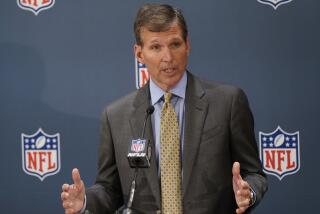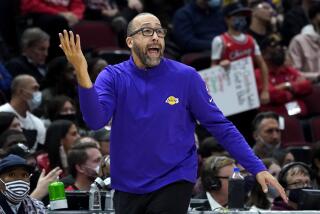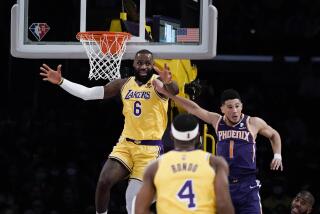NBA has been out front on coronavirus, but future remains unclear

- Share via
There was Commissioner Adam Silver, sitting in a mostly empty studio Wednesday, answering questions about the new NBA, one in which the league could crown a champion in August in an empty arena and could have its schedule severely altered because of the coronavirus.
Eight days earlier, there was Brooklyn Nets coach Jacque Vaughn, sitting in an auxiliary dressing room at Staples Center, wondering what the NBA might end up looking like if fans were kept out of arenas and musing about the subtle changes to life in the league during a pandemic.
The Nets were scheduled to move through several coronavirus hot zones — Los Angeles, Sacramento, L.A. again, and San Francisco. The best defense, they thought, was increased hand washing.
“Think how much has changed in just a week,” Silver said.
If social distancing, curbside takeout, daily presidential news conferences and positive COVID-19 tests weren’t enough reminder, here was the NBA commissioner, an optimist, unable to give a clear answer on when the league could return.
“I honestly don’t know,” he said frankly.
That was one of the messages Silver tried to convey during his interview with ESPN’s Rachel Nichols, his second public comments since the suspension of the season last week.
“I’m optimistic by nature and I want to believe that we’re going to be able to salvage at least some portions of this season,” Silver said. “I would say we have done new and creative things in the past, we experimented with this year’s All-Star game with a unique ending. We’ve talked about play-in tournaments for going into the playoffs. There may be other things we can do with the format.
“… We’re gonna try by every means we can to play basketball again, but I say that the safety and health of our players is first, and our fans, which is why I don’t want to speculate more on that. That will be the condition upon which we can play: When public health officials give us the OK.”
Silver said he wanted the NBA — the first national entity to pull the emergency brake because of the coronavirus outbreak — to be one of the leaders in kick-starting the battered economy.
That means the league is exploring ways to return to action in three ways, Silver said. The first, and the most preferred option, would be a return to normalcy, games played in arenas full of fans.
A second option, Silver said, would be a return to games without fans in attendance — which the league was bracing for before Utah Jazz center Rudy Gobert tested positive March 11. While there could be rules against gatherings of a certain size — it’d be impossible to put on a NBA game with fewer than 50 people inside under current protocols — the league has floated ideas for ways it could work, primarily limiting assistant coaches, while having off-site broadcasters and using remote cameras.
Silver floated a third option for the meantime: some type of charity game where a group of players could compete if there were circumstances that could guarantee their health and safety, whether it be testing or quarantine or isolation.
“People are stuck at home,” Silver said. “They need a diversion. They need to be entertained.”
Geoffrey Dreher, a primary care sports medicine physician and assistant professor of orthopaedic surgery at Johns Hopkins University, praised the NBA’s quick action last week.
“I think it was impressive,” said Dreher, who also serves as a team physician for Johns Hopkins athletes. “The quick decision-making they did after that first diagnosis, looking in hindsight I think it was the right decision and was a tipping point especially in the public eye to kind of pandemic that’s going on and the severity that athletes, the sports world, as well as the general population, should be more aware of this.”
The social impact has been part of the league’s defense for players and teams getting tested at a time of shortage, with critics accusing NBA teams and players of cutting in line. Silver said eight full teams underwent testing for COVID-19, including an unknown number of players who have exhibited symptoms. Silver, who hasn’t taken a test for the coronavirus, said none of the seven known cases in the league are serious, with two of the players suffering from “mild” symptoms.
When pressed about the testing Wednesday, Silver again pointed to the positive impact Gobert’s test had in sobering society to the realities of the virus.
“I understand there are many sides to these issues,” Silver said. “But I also think that by virtue of an NBA player being tested and the kind of attention it brought, my sense was — especially among young people in the United States — people were not taking these protocols all that seriously until the NBA did what it did.”
Now that so much of society has ground to a halt, Silver said the NBA has the responsibility to be a part of the restart.
“I’ve heard from several of our teams and something I’ve been thinking about a lot is to the extent we were the first to shut our league down, in what ways can we be the first movers to help restart the economy,” he said.
That happens on the court, including games getting pushed up against the start of the NFL season. It’s all on the table, he said, including looking to start the 2020-21 season in December, redefining the idea of when “basketball season” is played. The major drawback isthe notion that ratings are softer in the summer when people watch less television and the NBA Finals conclude.
There might be tougher decisions to make — the toughest a possible full-on cancellation and fallout from an empty season.
“I’m not there yet,” he said. “We’ll figure it out, but I hope I’m not just in denial.”
Staff writer Andrew Greif contributed to this report.
More to Read
Go beyond the scoreboard
Get the latest on L.A.'s teams in the daily Sports Report newsletter.
You may occasionally receive promotional content from the Los Angeles Times.











